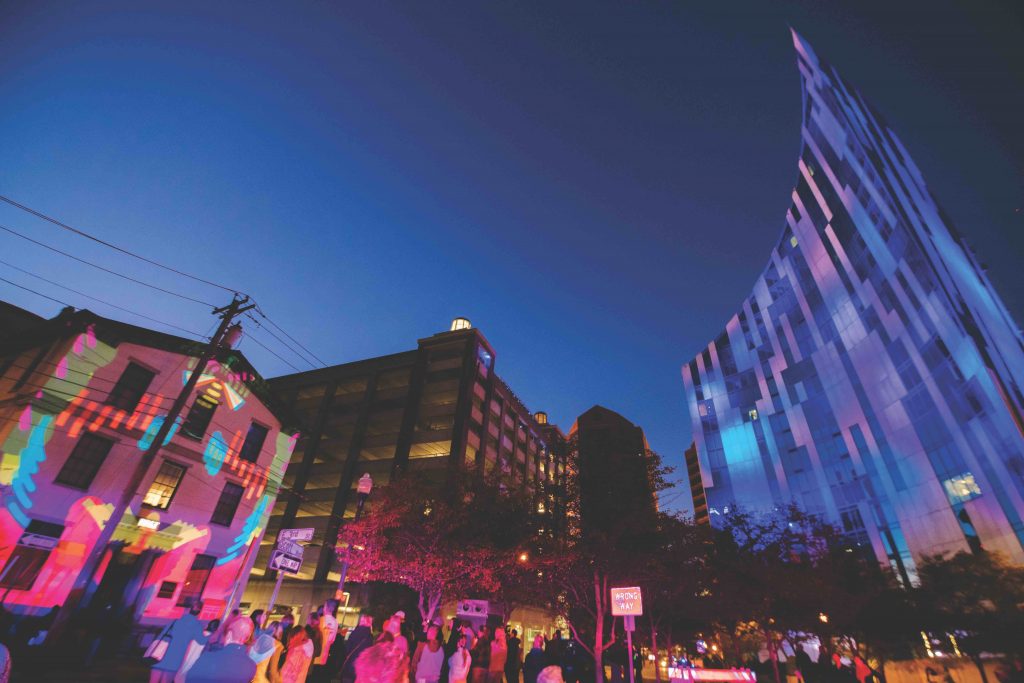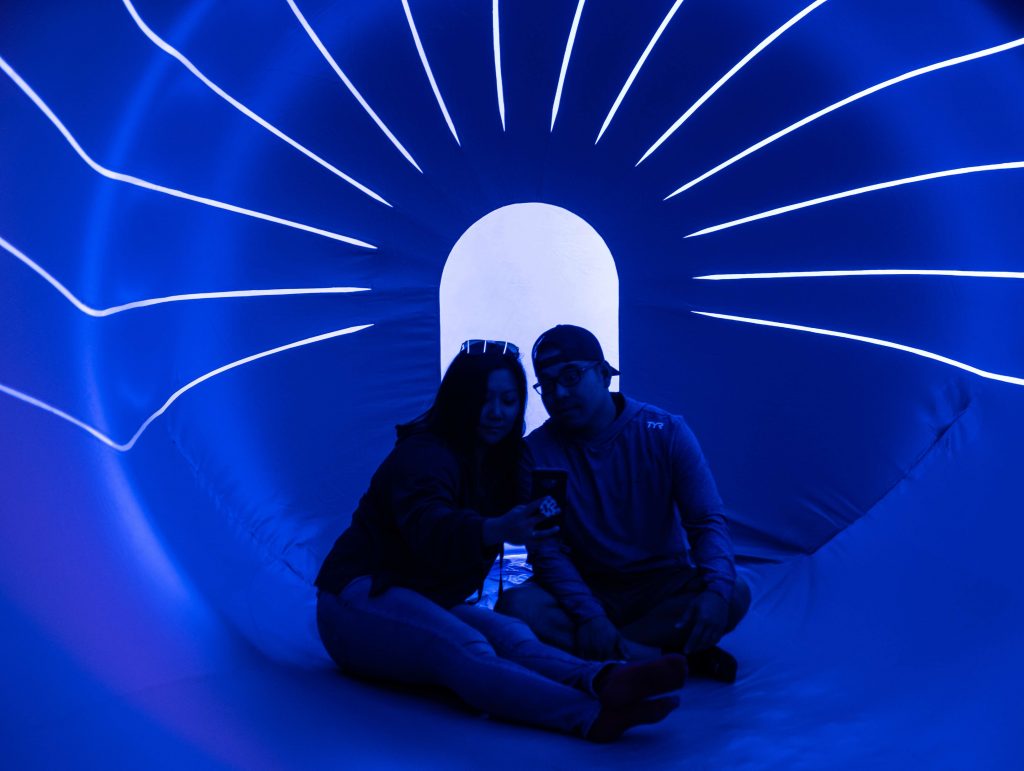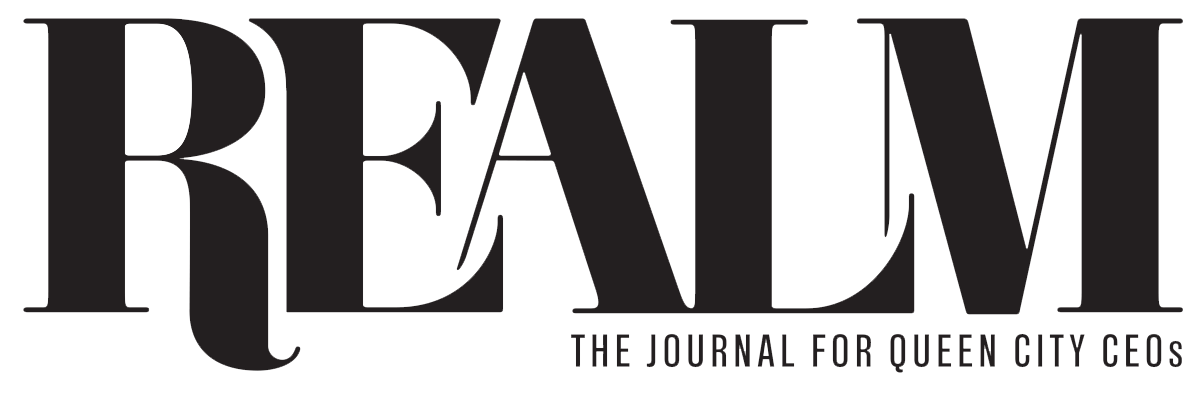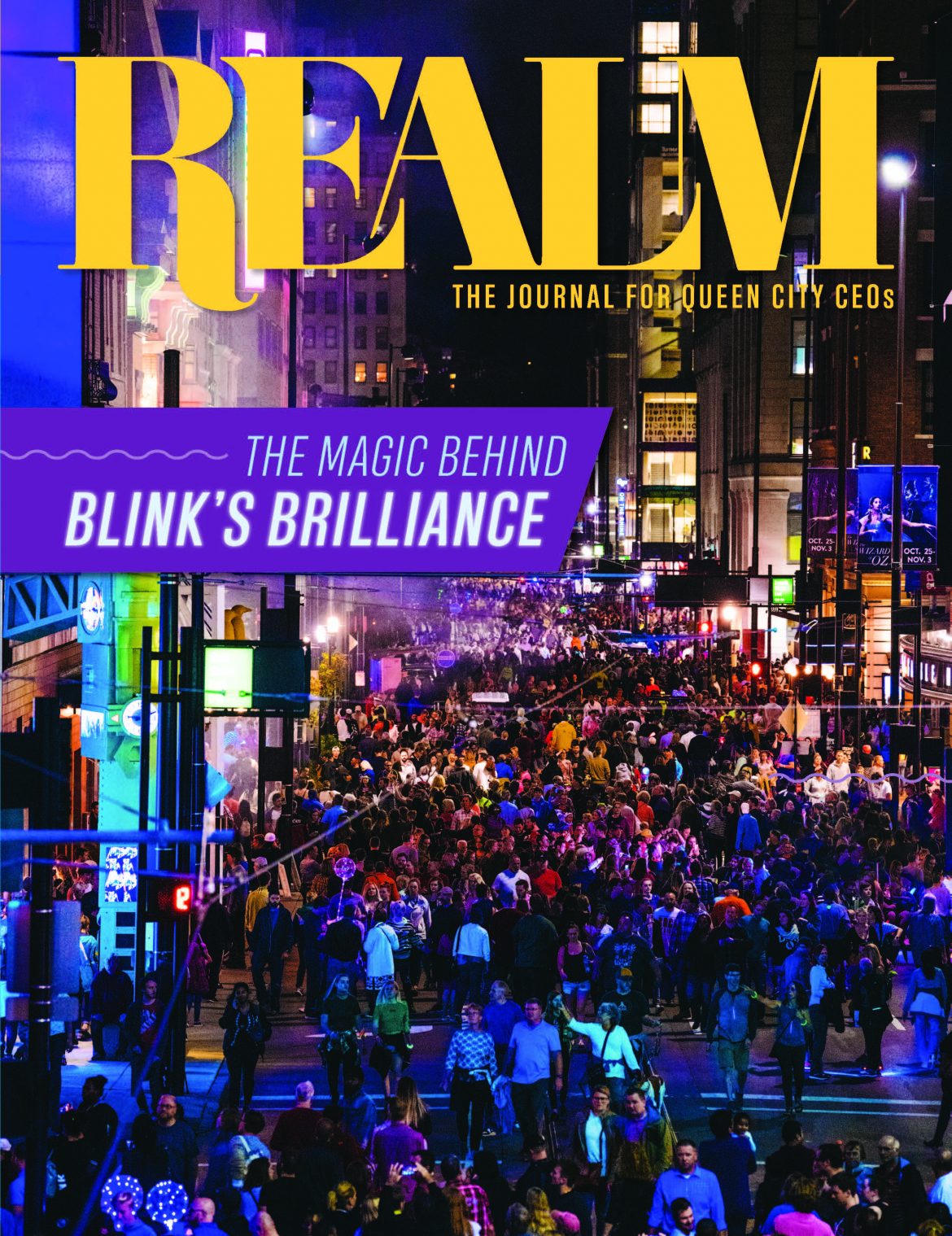The heralded light- and art-focused BLINK weekend returns for its third staging October 13–16 after a pandemic-induced delay, and those in charge say they’ve learned a thing or two over the course of its breakout 2017 and 2019 versions. The third time, as the saying goes, might be the charm.
At the helm is Justin Brookhart, who takes the reins of BLINK as its first-ever executive director. Brought on board by the Cincinnati USA Regional Chamber at the beginning of this year, he’s worked closely with festival partners AGAR, ArtWorks, the Carol Ann and Ralph V. Haile Jr. Foundation, and Cincy Nice to make this year’s event an even bigger spectacle than before. And when the only thing you’re measured by is your own uncontested past success, the sky’s the limit. “Figuring out how to evolve without messing up that secret sauce is the key to this year and future iterations,” says Brookhart.
He’s well-versed there. A film school graduate with a master’s degree in public affairs, Brookhart helped scale up Mondo, a movie and pop-culture retail brand founded in Austin, Texas, in the early 2000s, from a tiny gallery in the Alamo Drafthouse to a multi-million dollar organization, serving as managing director and vice president of operations by 2017. The company launched MondoCon, its own convention for fans that curated opportunities for conversation and connection.
“What informs my work here at BLINK is really thinking about how you take a weird, creative idea and operationalize it and grow it over time,” says Brookhart. “BLINK isn’t possible because of me or any of the other partners who help produce this thing—it’s possible because we help bring incredible talent to town and empower local artists, and then set them up to succeed. That’s a huge emphasis for me.”
BLINK will once again feature new murals, projection mapping, and light installations, but in the spirit of being more artist-forward, organizers put out an international call to artists. In the past, BLINK did a combination of soliciting calls for artists in certain disciplines and direct curation for others.
“What we did this year is we asked ourselves, What if we opened up all the disciplines and said anyone who wants to join in the collaboration raise their hand, locally and internationally,” says Brookhart. “That was a big experiment. We were curious what that was going to do to the blended mix of local versus national versus international and how that evolves.”
The call to artists was on a fairly condensed timeline, but it was nonetheless illuminating, no pun intended. “What we learned is there’s just a ton of talent here locally in the Cincinnati region who haven’t felt like they had an opportunity to join the collaboration,” says Brookhart. “And we’ve opened up opportunities to those folks, which is really exciting. We’ve also seen the reach of this event. BLINK has made a global impression, which folks here might not know about.”

Wendy Yu is an Australia-born interdisciplinary artist who works at the intersection of dance and urban media art, which she’ll showcase during BLINK at the Federal Reserve Building at Fourth and Main streets. She recently completed a research proposal for her thesis dissertation on the position of breakdancers in urban media art. One of her best known works is a partnership with Adidas to launch its Harden Vol. 6 sneakers, which culminated in a projection outside of the Barclays Center in Brooklyn.
“The attention that BLINK has for artists is really, really inspiring,” Yu says via Zoom from Australia. “BLINK curates such different artists from different backgrounds and respects them. What’s really interesting about projection art is that people have such diverse backgrounds before they come into it.”
Yu is working with Elementz, the OTR-based hip-hop cultural arts center, to shine BLINK’s literal spotlight on breakdancing, which in 2024 will enter the Olympic pantheon as a competitive sport. “Breakdance and street dancers have such a history of being appropriated practices in street culture and spatial cultures,” she says. “They’ve had to always create space for themselves, and so when we’re now using urban media technologies—for example, high-lumen projectors or urban screens—to showcase breakdance, we’re elevating these local athletes and bringing a higher visibility to practitioners in Cincinnati. It’s fun to just track that progression of breakdance from being a form of dance with a lot of negative stigma into such a glorified and accepted artform or even sport.”
Creating an international collaboration is no small feat, especially when the choreographer can’t be in person with the dancers to set the piece. Yu uses what she calls “soft choreography,” a suggestion of movements, and allows the Elementz dancers to do what they do and know best, capturing it on camera to then fine-tune the final projected product. BLINK audiences will see a looped projection of individual dance segments.
“The dancers just have a few boundaries within which the movement can exist,” says Yu. “The rules are basically just staying in frame, maybe giving them a depth calculator to see where their body cuts out of frame. With those parameters in place, I want to be representing the dancers’ individual skills, so I’m not going to be choreographing the dance. I’m very happy for them to bring in their own improvisation or something that makes them feel represented on an urban media landscape.”
Yu has a BFA degree in dance and a master’s degree from the University of Sydney in Interaction Design and Electronic Arts. Her foray into projection art began when she was a student, making interactive designs on her computer. The screen was small, so a friend suggested she hook it up to a projector. Her projection work has taken her across the world, including now to Cincinnati audiences.
“One of my mentors said, People are attracted to projection art because it’s quite Promethean, like the fire that gathers early mankind around at night to tell stories,” she says. “It was always my intention when designing projection for it to stimulate people to gather around to tell stories. With breakdance, especially street dance cultures, it just seems to have and hold a really vibrant history for storytelling.”

More than 300 people submitted to BLINK’s call for artists, and two waves were announced by the end of August. Several artists are making a return appearance, including Mallory Feltz, who has the distinction of participating in all three iterations—a veritable BLINK hat trick.
“When BLINK came about, it was an opportunity to make work that was going to be seen by a lot of people and experienced by a lot of people,” she says. “I wanted to share the joy of creativity and the joy of art with other people. With my BLINK pieces, there’s always a little bit of a surprise element, whether it’s how you interact with the piece or something you may not initially notice.”
“Easy Breezy,” her contribution to BLINK in 2017, was one of the most talked about on social media, featuring an installation of glowing umbrellas arranged in a canopy over Michael Bany Alley in Over-the-Rhine, next to the Hanke Building and Japp’s. “They were very simple umbrellas that were just highlighted with lights, but then they were set on motion sensors and so they moved and interacted with you,” says Feltz. “I know a lot of people who are coming to see BLINK don’t have a background in art, and you don’t need one to enjoy what’s going on. I think it’s really important and fun to remember this artwork isfor everyone to experience and to have a different relationship with what they’re seeing.”
Feltz earned her BFA in Sculpture from DAAP at the University of Cincinnati and her MFA in Sculpture from Louisiana State University. She incorporates themes of domesticity and home life in her works, using commonly found materials and items as an “approach point” for viewers to be able to relate to them. Case in point is her 2019 BLINK contribution, “Toy Box,” which featured seven different giant nightlights based on traditional toy icons. When people walked by, the nightlights were activated via motion sensors and gave off different-colored glows. She observed how folks interacted with the display but was slightly disappointed that the motion activation wasn’t more directly controlled by the individual.
This year, the control is in the viewers’ hands. Or rather feet. “A lot of guests want a direct interaction with the work and want to feel part of it,” says Feltz. “So this year my piece called ‘Linger’ is a series of lamps with words and phrases written in glow-in-the-dark paint on the lampshades. They’re installed on risers, like choral risers, and are powered by foot pedals that come out from each lamp that guests can step on and turn on the lights.”
“Linger” will be installed in Imagination Alley on Vine Street between 13th and 14th streets. To accommodate all potential types of weather, Feltz says she engineered her design to include outdoor waterproof lamps and is building the risers herself to house the electronics inside waterproof surfaces. The foot pedals are also waterproof and shockproof, and she tested several different paints for brightness and length of electric charge. The paint holds illumination because it contains phosphorescent powder, itself contained within a gel medium that glows when it absorbs light.
“I was thinking about being in our homes all the time during COVID and living within that space, and then thinking of living within your body as a space and how I have trouble sleeping because it’s hard for me to shut off my brain sometimes,” says Feltz. “This work pays homage to all of the interruptive, sometimes funny, sometimes introspective words and phrases that just pop into your brain. I always hope that people take away the idea that creativity doesn’t have to be complicated but can be approachable. Art is for everyone, and there are plenty of surprises in our daily lives.”
A new artist to BLINK this year is Cincinnati-based Michael Coppage, although you may already be somewhat familiar with his work if you’ve ever wandered down Gano Alley next to downtown’s 21C Museum Hotel. The alley is lined in murals from his “Black Box” series, featuring black and white images of Black men. During BLINK, Coppage is installing a 54-foot temporary vinyl mural just across the street on the facade of the Aronoff Center for the Arts, working with Cincinnati designer Jason Snell for light projection and animation.
“From 2020 on, I would say we all have gone through a collective trauma in many ways, from active shooters to COVID to George Floyd to abortion rights,” says Coppage. “I just thought about doing something that worked against that and provided some joy in the midst of all that. I essentially proposed a Care Bear, which is a big guy sharing positive messages and affirmations and shooting the crowd with love and light. I’m hoping to build something visually interesting that creates a sense of awe and wonder.”
Coppage has storyboarded the mural animation to take viewers through the four seasons, starting with spring. He incorporates plenty of well-known Cincinnati icons, like the state bird (cardinal) and the state flower (carnation), plus nostalgia and pop culture elements as well. The mural itself is a photograph of John Willis, an actor and mental health/behavioral health specialist at Cincinnati Children’s Hospital Medical Center. “I wanted it to be someone I look up to,” says Coppage, who also serves as an operational supervisor at the Talbert House. “When you see John that big and you look up to him, it’s because I already look up to him. I think he’s a great representative for carrying that message of caring and joy and love.”
Willis was also involved in Coppage’s “Black Box” installation, in which the artist offered 13 photographs of men as entry points for frank discussions about race and society. The project reached more than a million people with repeat installations in 17 different countries, six states, and Puerto Rico. “Once I combined my experience with mental health into my art practice, it fundamentally changed the focus of the work I was doing,” says Coppage. “To be able to take something I really believe in and include it in BLINK reaffirms for me that, one, I’m making the kind of work I should be making and, two, there are other people who are willing to offer their platforms to share this work because they believe in that mission as well.”
Coppage says BLINK’s inclusion of local artists and socially relevant themes is a win for Cincinnati because when people see that his work is featured in a prominent location, it’s almost like their work is included, too. “I didn’t know anyone who had participated in BLINK, though I used to go every year and was blown away by how beautiful everything was,” he says. “I put BLINK on my bucket list, hoping I could one day create for other people the feeling I was experiencing myself attending the event. I finally get the chance to do that, and it’s just really serendipitous. I’m really looking forward to seeing how people respond to it.”

Murals have been a cornerstone of BLINK from the very beginning, both in their own right and as canvases for imaginative projection animation and light mapping. AGAR, one of BLINK’s producing partners, has been inspired over the years by the Wynwood neighborhood in Miami, Florida, where the Wynwood Walls function as an outdoor street art museum, with graffiti and mural art from such industry greats as Shepard Fairey. Previously involved in LumenoCity, the precursor event to BLINK, AGAR is stepping up to again combine lights, projection mapping, and mural art for the 2022 weekend.
“We all kind of looked at each other and said we wanted to do something different and bigger,” says Andrew Salzbrun, AGAR’s managing partner. “AGAR had been doing a lot of work in Wynwood in Miami and saw just the power of densely populated international public art and how it transformed neighborhoods by economically impacting them through tourism, hospitality, residential development, and a sense of placemaking.”
The AGAR team brought that inspiration back to Cincinnati, sharing it with the Findlay Market board and Tim Maloney of the Haile Foundation, a primary backer over the years of both BLINK and LumenoCity. Using their connections and their industry insight, AGAR took on the mural mantle, importing world-renowned artists to transform the walls around Findlay Market. That same ethos is the standard to this day.
“We aren’t prescriptive in the artwork that our artists bring to BLINK,” says Salzbrun. “We asked them not to be laced with profanity or big political messages and that they can be kid- and family-safe, but otherwise we don’t give them a theme, direction, or colors to stick within. It allows us to showcase world-class artists in a blank-canvas situation and expose that to a large amount of people all at once. We’ve gone out of our way to spend a significant amount of time recruiting the best artists in the world to come here and be a part of our portfolio.”
There are 17 murals going up during this year’s BLINK event. Two were selected through the call-to-artists process, and others are from artists AGAR has been attempting to bring to BLINK for several years. In total, including this year’s new additions, there are about 45 murals across the urban core that have been installed for BLINK. Practicality restricts projection-mapping all of them. “We typically choose five to six that either have a great story or would lend themselves well to projection mapping,” says Salzbrun. “Some of the muralists will come in with a projection mapping artist in tandem.”
In 2019, a mural by artist Faith 47 at the corner of Vine and Liberty, depicting a woman riding a horse with a flag (thematically based on Eirene, the Greek goddess of peace), was projection mapped by South African artist Inka Kendzia. The result proved so popular and so compelling that AGAR is bringing Kendzia back this year to do another show on that same mural.
“One of the biggest ‘gets’ for us this year is Insane 51 out of Greece,” says Salzbrun. “He’s a muralist who paints in a technique where the viewer wears 3D glasses. It’s so cool. He basically paints the same image three times: One is the subject’s flesh layer, one is the skeletal layer, and the third is the combined image between the two, so when you wear 3D glasses you can just experience this mural in an incredibly interactive way.”
Other muralists this year include Tristan Eaton, one of the biggest street artists in the world right now; PichiAvo, a duo of street artists from Valencia, Spain; CASE Maclaim from Germany; Cincinnati-based Chris Gliebe, who uses the street moniker “The Devious;” and the anonymous art collective Mz.Icar. AGAR is also helping lead the weekend’s musical component this year, with several acts set to perform on stages within the BLINK footprint, including at Washington Park and Fountain Square.

There are five designated BLINK Zones: Over-the-Rhine, Findlay Market, the Central Business District, The Banks, and Covington. It can be overwhelming to navigate all five areas, and if attendees need a bit of a respite in the midst of BLINK revelry, CincyNice is ready to answer the call.
The collective, led by siblings Destinee Thomas and Billy Thomas, formed during BLINK 2019 as an opportunity to carve out space within the event footprint for artists, musicians, and other creative individuals to connect with each other and with visitors. CincyNice established a home base at Switch Lighting, a storefront on Fourth Street, to create a social house filled with art, lighting, and couches. They saw more than 1,000 people during the 2019 event, including visiting BLINK artists, and realized the special opportunity they had to offer a connection point during an event that attracted more than 1 million visitors.
“We’re very excited to bring back the CincyNice Social House,” says Billy Thomas. “It’s a space of welcomeness where people can connect, and we’re looking to work with a lot of diverse local and national creatives to bring the space to life. We want people across the city generally to feel like BLINK is theirs as well.”
This year’s Social House will be located in the former People’s Liberty space in the Globe Building across from Findlay Market. The team will host several nights of programming featuring musicians and storytelling. “There’s something really special about the feeling of You’re welcome that Black people in particular do, and there’s something really special about welcoming you into a home,” says Destinee Thomas. “I want people to feel that warmth and that moment to be themselves within the city, and I hope they’ll keep coming back for more of their most authentic self and keep creating that beyond BLINK.”
In the end, that’s really what this four-day experience boils down to: creating connection to both oneself and to one’s community. “The whole point of BLINK is you’re on the streets, you’re in our public parks, you’re in those places and you’re with the community as a whole in a shared experience,” says Brookhart. “It’s those stories I hear about, like, Oh, I was out at a park and I saw a public marriage proposal, or I was looking at this thing and I got really emotional, and I looked next to me and a stranger was also getting really emotional, or My kid loved this thing and he was playing with a bunch of other kids. It’s that shared experience that people take away more than anything. Making sure that feels celebrated is really important to us.”


